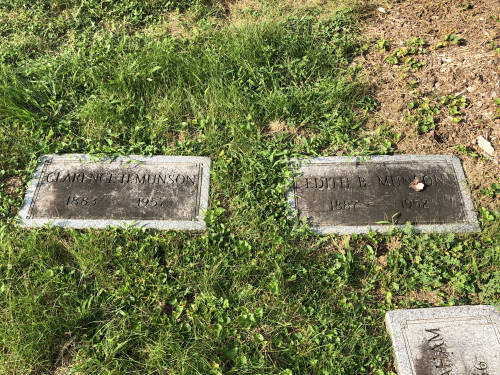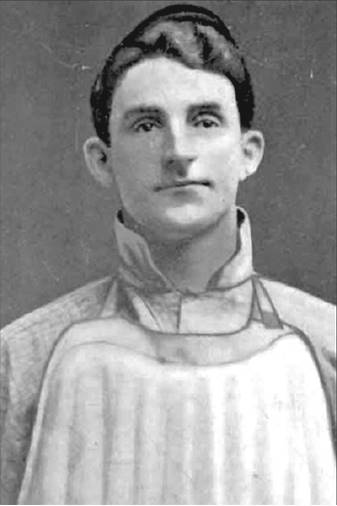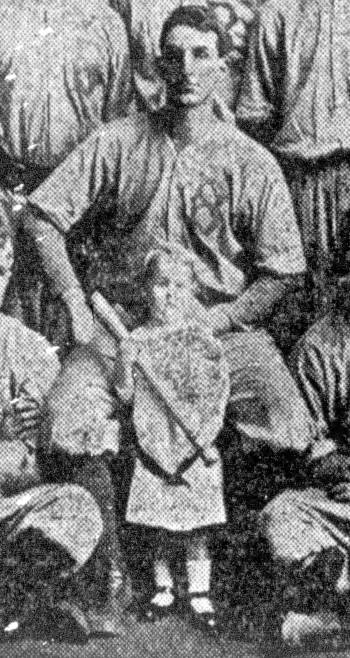Here lies Red Munson, who had a major-league career as a catcher for a total of nine games. After that, he earned a reputation as an excellent catcher and manager in the minor leagues. Munson played for the 1905 Philadelphia Phillies.
Clarence Hanford “Red” Munson was born in Cincinnati on July 31, 1883. The nickname was due to his hair color, naturally. His father George, born in Connecticut, worked as a grain merchant in Ohio, where he married the former Clara Margaret Matthews. Clarence, according to the 1900 census, was the only son of four children. That census also reported that the 16-year-old was working as an assistant engineer – presumably on a steamboat.
Munson started playing ball on independent teams in and around Cincinnati. In 1903, he was the catcher for a team in Charlestown, W.V. He tried out for the St. Louis Browns in 1904, traveling with the team to spring training in Corsicana, Texas. One report indicated that he stayed with the team for three weeks after the season began, but he never got into a game. He apparently returned home to Cincinnati when an opportunity arose in Akron. The team’s catcher, Paddy Livingston, suffered a split finger that took time to heal. Akron’s business manager wired for Munson to come and join the team.

“Munson is recommended by Manager Drumm of Zanesville and Anderson, formerly with Marietta… Managers Drumm and Anderson say that Munson is a front rank man, that he can bat, throw and field his position excellently,” reported the Akron Beacon Journal. Munson, who was 21 years old at the time, reportedly stood about 6 feet tall (Baseball Reference lists him at 5’11”) and was well proportioned for his size. He reportedly weighed 175 pounds when he made the majors, but Baseball Reference oddly does not list a weight.
By the end of the season, Munson had become one of the ballclub’s most popular players. He almost missed one game on September 7 against Sharon due to a headache. He started the game anyway and singled three times, including twice with the bases loaded, before being lifted for a replacement. “Here after it will be the duty of a club employee to put something in “Red” Munson’s coffee that will produce a headache,” the Journal joked.
The one question about Munson was his arm. After several weeks of not being tested in front of the home crowd, a baserunner tried to steal second in an early September game. Munson, faced with a slow curve and a batter who got in his way, nevertheless fired a perfect strike to second base – where it caught the baserunner right in the head. Nobody else tried to steal on Munson that day.
When the 1904 season ended, Munson traveled home to Cincinnati to work as an engineer for a steamboat company, traveling between Cincinnati and New Orleans. It was expected that he would return to Akron, but he jumped his contract to play for a professional team, the Charleston (S.C.) Sea Gulls of the South Atlantic League. It wasn’t an unexpected development, as Munson had been regarded as one of the top backstops in the independent circuit.
While in Cincinnati over the winter, Munson put his own life on the line to save a man from drowning. The February 10, 1905 edition of The Cincinnati Enquirer reports that Munson was ice skating on the frozen Ohio River near the Waterworks. An older gentleman who was watching the skaters fell in the water when the ice under his feet gave way. Munson called for help, but with nobody nearby, he tried to pull the floundering man out of the freezing water himself. He too fell in the river but managed to extricate himself. Screaming for help, Munson lay on his belly on the ice to try to pull the man out. Fortunately, a couple of passers-by heard Munson’s screams and grabbed the catcher by the legs, forming a human chain that eventually pulled the drowning man out of the river.

Munson became as popular in his new city as he had been in Akron. He caught all 19 innings of a 1-0 against Columbia, recording 3 of his team’s 6 hits. He showed his scrappiness in an exhibition game against Brooklyn in mid-April. Munson served as the game’s umpire, and when Brooklyn manager Jimmy Sheckard got into an argument with him and said a few choice words, Munson grabbed the skipper by the neck and landed a half-dozen or more punches before they were separated.
Munson batted .224 for the Sea Gulls in 1905. In late August, the Philadelphia Phillies purchased his contract and kept him on the roster for the remainder of the season. He backed up Charlie “Red” Dooin, giving the Phillies not one but two red-headed catchers who were born in Cincinnati. Munson’s debut on August 28 against Pittsburgh was a disaster. He singled in four at-bats against Deacon Phillippe, but defensively, he was a mess. He failed to field a bunt that went for a hit, committed a passed ball and overthrew second base twice in one inning. The Pirates stole five bases on him, including two each by Fred Clarke and Honus Wagner. Clarke added a further indignity by knocking the ball out of Munson’s hand on a play at the plate, which was scored an error. The Phillies lost 4-2, and most of the Pirates runs were the result of Munson’s misplays.
Munson appeared in a total of 9 games for the Phillies in 1905. He had 3 hits, including a double, in 26 at-bats for a .115/.115/.154 slash line. He scored once and drove in 2 runs. Munson threw out 7 of 15 baserunners for a 47% caught stealing rate, which is very good. However, he committed 7 errors in 8 games as a catcher for an .857 fielding percentage. Munson was thought of as a very good catcher, so his poor performance there seemed like an aberration.
Munson never played in the majors again but continued to catch in the minors for most of the next decade. Philadelphia released him, as manager Hugh Duffy felt he needed more experience in the minors. He played a few games in Augusta, Ga., to no great success before spending most of the next few seasons with various Ohio teams.
Munson’s offensive stats aren’t great, but he was considered a pretty valuable catcher. His throwing arm was reportedly lame from working too hard, but he was well-respected for his work ethic and his treatment of teammates. When he joined the Canton Watchmakers in 1908, he didn’t play much at first, but he took over the practices and had his teammates moving at top speed. “…[H]is voice, which was of foghorn dimensions, could be heard from blocks away,” the press reported.
It was rumored that the Cincinnati Reds made overtures for Munson to work with the team as a pitching coach in 1909, but the catcher decided to sign with the Norfolk Tars of the Virginia League. His first year with the team was a weak one, but he had the best season of his career in 1910. He batted .260 in 108 games and smacked 3 home runs, which actually led the team.
Unfortunately, he couldn’t repeat his success with Nashville in 1911. He hit .207 in 68 games with the Vols in what was his only season of Class-A minor-league baseball. He did cause a sensation by being one of the first Vols to own an automobile, and he could often be seen driving around downtown Nashville with his family and friends. “It’s a runabout all right,” he said of his automobile. “It runs about ten feet and then stops.”
The Bristol (Tenn.) Boosters decided to make Munson their catcher/manager for the 1912 season, and it was a logical decision. Munson, at 28 years old, was seemingly fading fast as a player, but he had shown good leadership qualities as a player. He went about building a competitive team, and the Boosters went from last place in 1911 to the Appalachian League champions in 1912. Munson didn’t have a wealth of future major-league talent on the roster. The consensus was that Munson motivated his pack of average talent to become the best in the league. He celebrated his championship by returning to Cincinnati and his day job: inspecting bananas and exterminating the tarantulas that were hiding among the fruit for a wholesaler.

One of his finds, pitcher Nick Cullop, had a few good seasons in the majors in the years to come. Munson said he practically begged for scouts to sign Cullop, but nobody took him up on the offer. The Boosters ended up selling him to New Orleans for $1,200. Shortly after, the Cleveland Naps bought him for a small fortune, though Cullop initially refused to go. When he signed with Cleveland, it was because Munson brought the indecisive pitcher back to Bristol and told him it would be a folly to not sign with the Naps.
Bristol failed to repeat as champs in 1913, though Munson was a part of the championship series, between Johnson City and Knoxville, as an umpire. The offseason was a stressful one, as there were some rumors that the Appalachian League might fold entirely, with several teams in debt. Munson spent the spring coaching the baseball team at Emory and Henry College in Emory, Va. When word got out that the Appalachian League was indeed shuttered, he joined the Paris (Ky.,) ballclub of the Ohio State League. That team folded as well, less than a month later.
The statistics from the minor leagues in this era are incomplete and sketchy at best, but Munson had 497 career hits in 9 seasons in the minors for a .222 batting average.
Munson caught on with the Cleveland Naps of the American League after the Paris team ceased operations, and he was put in charge of developing the team’s young pitchers. That was his last role in professional baseball. He took a job managing a semipro team in Kokomo, Ind., in 1915, but he was fired in June. He spent a couple of seasons in the Cincinnati semipro circuit, playing for a team in Norwood. He also was an umpire in Cincinnati for many years.
By the time of the 1920 census, Munson was working as a foreman at a gas company and living in Norwood. He played ball on the Union Gas and Electric Co. ballclub, and the team was known for its “red battery.” Munson was the catcher and Red Kelley was the pitcher. By the 1930s, Red Munson was back in the news as a catcher in the Cardinals organization. It wasn’t Clarence, though. He and his wife Edith had moved to Silverton, Ohio, and he worked as a salesman for Silvertone Supply Co., a building supply company. The Red Munson in the news was his son George, who was a good high school athlete and spent a couple of seasons in pro ball.
Edith Munson died on June 18, 1952, in Silverton at the age of 65. She and Clarence had been married for 44 years. He retired from his job at Silvertone Supply in 1954 and moved to New Orleans, where his son George worked as a field director for the Red Cross. Red Munson died on February 19, 1957, in Mishawaka, Ind., at the age of 73. He had traveled to Indiana to visit his sister when he was stricken by a heart attack. He was buried in Spring Grove Cemetery in Cincinnati, Ohio.
Follow me on Instagram: @rip_mlb
Follow me on Facebook: ripbaseball
Follow me on Bluesky: @ripmlb
Follow me on Threads: @rip_mlb
Follow me on X: @rip_mlb
Support RIP Baseball



